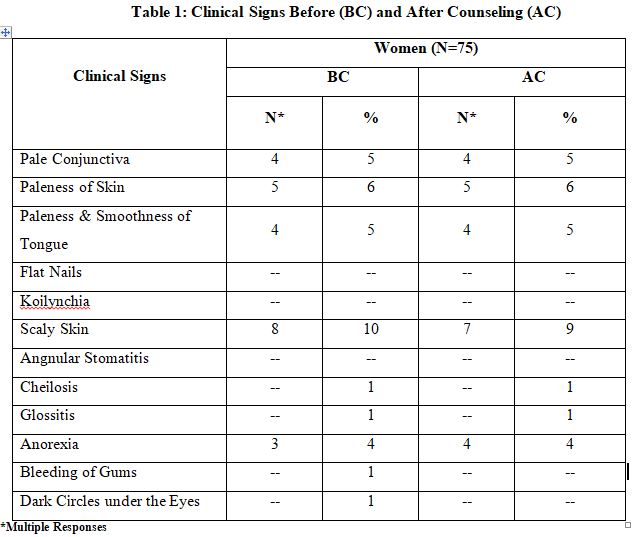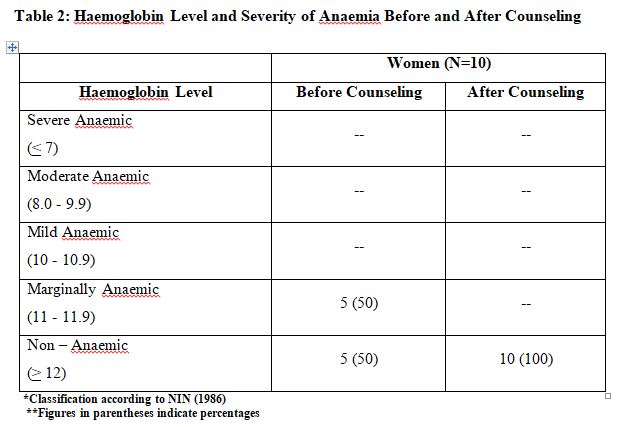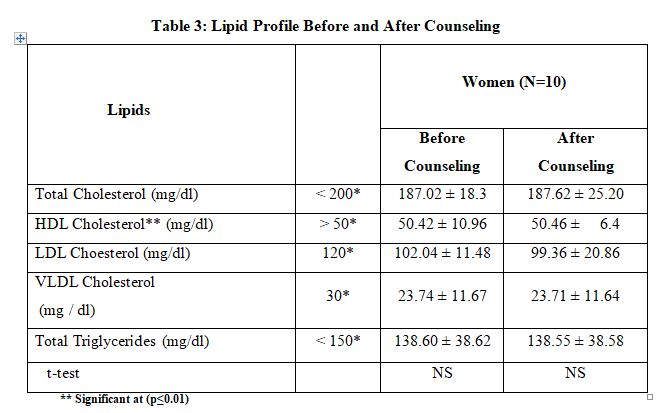Alleviation: An International Journal of Nutrition, Gender & Social Development, ISSN 2348-9340, Volume 9, Number 9 (2022):1-8
© Arya PG College (College with Potential for Excellence Status by UGC) & Business Press India Publication, Delhi
http://apcjournals.com, www.aryapgcollege.ac.in
Impact of Nutrition Education on the Health of Women
Abha Khetarpal
Formerly Officiating Principal and Associate Professor
Department of Home Science
DAV College for Girls, Yamunanagar
(Haryana), India
Email: abhakhetarpal@rediffmail.com
Abstract
The present study deals with the improvement in the blood and lipid profile of women after counseling for six months. Seventy-five women from different age groups, economic and marital status and hailing from various districts of Haryana were enrolled for the study. Nutrition education was imparted individually followed by group contacts for a period of six months through modules, lectures, demonstrations, leaflets and visual aids. The subjects showed the positive impact of counseling as a reduction in the clinical signs of malnutrition especially of vitamin B-complex and vitamin C were observed. Following counseling for six months, an increase in the Hb level of women was observed. In the corresponding groups, the haemoglobin level increased to-12.4 to 12.9 g\dl and all the subjects were in the category of non-anaemic subjects. It was deduced that the nearly normal lipid profile of housewives improved non-significantly after counseling for six months. It was observed that increase in physical activity levels, improved dietary intake along with positive life style changes resulted in bringing about the desirable changes in the lipid parameters of women. Women's health is of utmost importance as it reflects the health of the family but in some cases, conflicting demands of work in the home have been shown to have adverse effects on her nutritional status. However, if they want to be accepted as efficient homemakers, they have to consume a nutritionally balanced diet. This will not only improve their health and nutritional status but will also reduce their weight. Since our health and nutritional status depends on the food we eat, the components of the diet must be chosen judiciously, to provide all the nutrients needed in adequate amounts and proportions.
Keywords: Counselling, Dietary Intake, Haemoglobin, Lipid.
Introduction
The nutritional status reflects the health of a person and is influenced not only by the diet consumed but also on the ability of the body to utilize these foods (Mehta & Dodd 1990). The counseling is used as an intervention for the promotion of health by enhancing the knowledge of the respondents about the consumption of a balanced diet. The first requirement of nutritional counseling or advice is that it should enable the woman to assess her own diet and its composition and compare it with the advice. However, the counselor should emphasize upon bringing a change in the attitudes, knowledge and behaviour of an individual (Buttriss 1997). Eating well, drinking lots of water, consuming fresh fruits and vegetables boosts energy and water helps the body to function properly. The improved dietary habits can lead to changes in women’s general health and a disease-free life. It can minimize infections and chronic diseases and can reduce birth defects and health care costs. The adults with healthy life style also make good diet choices and acquire greater knowledge and more positive attitudes and beliefs about nutrition (Gates & Delucia 1998).
The present study was conducted on the women respondents belonging to Haryana state. The state was stratified into four zones and five districts were selected for carrying out the research. The selected districts were Yamunanagar, Panipat, Bhiwani, Faridabad and Gurgaon. Purposive selection of the subjects was done and 75 women were selected. The present study aims to provide a practical and positive approach to women to improve their health and nutritional status.
The objectives of the present study are:
1) To assess the clinical signs and lipid profile in women.
2) To impart counseling and to evaluate its impact on the health and lipid profile of women.
Methodology
The study on women was done in two phases. In the first phase, the field studies were done to collect the general information about the women respondents. The first phase of study was done on 75 women. In the second phase, the assessment of nutritional status of these women was done by doing clinical and biochemical assessment. For collecting the data, a questionnaire was drafted with definite, concrete and well-defined questions. Pre-testing of questionnaire was done on 30 subjects to find out the drawbacks and modify the questionnaire to ensure a clear understanding of the questions.
A meeting was arranged with the selected respondents to confirm their participation in the study and women selected for this study were assured of absolute anonymity. In the interview method, every respondent was interviewed individually and doubts if any were cleared by explaining each and every question. The respondents were requested to fill up the questionnaires within a week. The above information was obtained by using the questionnaire cum interview method both before and after counseling for six months. The nutritional status of the subjects was assessed from the clinical and biochemical assessment before and after counseling for six months.
Results and Discussion
Clinical Assessment
Scaly skin was noticed in 10 per cent of the subjects which reduced to 9 per cent after counseling in the respondents. However, no effect of counseling was evident in the number of subjects showing the clinical signs - pale conjunctiva, paleness of skin, paleness and smoothness of tongue and anorexia. The corresponding percentage of subjects showing the above signs were 5, 6, 5 and 4 per cent for each ailment which did not reduce after counseling. The subjects showed the positive impact of counseling as a reduction in the clinical signs of malnutrition especially of vitamin B-complex and vitamin C were observed. Close to the present findings, Johansson and Anderson (1998) also noticed an improvement in the intake of nutrients and a reduction in the clinical signs of malnutrition after counseling (Table 1).

Biochemical Assessment
Haemoglobin Levels of the Subjects and the Severity of Anaemia
Before counseling in case of women, 50 per cent of the subjects had the mean haemoglobin level in the range of 11.2 to 11.8 g\dl (Table 2) and were in the category of subjects suffering from marginal anaemia. However, the remaining 50 per cent of the subjects had the mean haemoglobinlevel between 12.4 to 12.9 g\dl and were in the category of non-anaemic subjects. Following counseling for six months, an increase in the Hb level of women was observed. The haemoglobin level increased from 12.4 to 12.9 g\dl and all the subjects were in the category of non-anaemic subjects. Arora (1997) and Kaur et. al. (1998) also noticed an improvement in the mean Hb levels of their subjects after counseling.

Lipid Profile
Total Cholesterol
Before Counseling, the mean serum total cholesterol level in women was 189.02 ± 18.3 mg / dl. However, as revealed in the Table 3, all had mean cholesterol level within the normal range of < 200mg / dl. In comparison with the present findings, Sharma (1998) and Kaur et. al. (2004) had observed lower values i.e. 187.5 ± 16.14 mg / dl and 187 ± 8.09 mg/dl respectively. However, after counseling for 6 months, a non-significant reduction in the cholesterol level of the subjects was observed and the respective decreased values of blood cholesterol in women was 187.62 ± 25.20 mg/dl (Table 3).
High Density Lipoprotein Cholesterol (HDL-C)
In comparison to the desirable level of > 50 mg/dl (Ghafoorunissa and Krishnaswami 1994), the mean HDL-Cholesterol level before counseling in women was 50.42 ± 10.96 respectively. The findings of the present study are in concurrence with the studies of Kaur et. al. (2004) who also reported a higher level of HDL-Cholesterol (47.2 ± 1.56 mg/dl) in women respondents with normal weight.

After counseling, a significant increase in the HDL-C level was observed in women (50.46 ± 6.4 mg. /dl). The findings of the present study are in accordance to the findings of Ghafoorunissa and Krishnaswami (1994) who proposed that it is desirable to have higher levels of HDL because they carry cholesterol from blood and tissues to liver to be processed for excretion.
Low Density Lipoprotein Cholesterol (LDL-C)
As observed in Table 3, the mean LDL-Cholesterol of women was 102.04 ± 11.48 mg/dl which was much lower than the upper limit of 120mg / dl. (Raghuram et. al. 2000). After counseling, the respective value decreased to 99.36 ± 20.86 mg/dl. However, the difference between the pre and post counseling values of LDL-Cholesterol was statistically non-significant. The findings of the present study reveal that counseling helped in the slight reduction in the LDL-C level of women thereby improving their health. The present findings are very close to the observations made by Krishnaswami and Ghafoorunissa (1999).
Very Low-Density Lipoprotein Cholesterol (VLDL-C)
Due to nearly normal weight, the VLDL-C level of women was considerably lower than the desirable limit of < 30mg / dl. The mean VLDL-C value for the corresponding subjects was 23.74 ± 11.67 mg/dl. However, after counseling, the respective values decreased to 23.71 ± 11.64 mg/dl but the decrease was non-significant. Further, statistical analysis of the VLDL-C values did not point out any significant variation in the VLDL-C value of housewives either in the beginning or at the end of the study. The findings are also very close to the observations made by Krishnaswami and Ghafoorunissa (1999).
Triglycerides
Before counseling, the mean total triglyceride (TG) level in housewives was 138.60 ± 38.62 mg/dl which was much lower than the reference standard of 150 mg/dl for a normal healthy adult. After counseling, the respective values reduced to 138.65 ± 38.58 mg/dl. The findings of the current study are in accordance to the observations made by Sharma (1998) who reported a lower triglyceride level (139.25 ± 25.55mg/dl) in women with normal weight. It was deduced from the above results obtained before and after counseling that the nearly normal lipid profile of the women improved non-significantly after counseling for six months (Table 3). In the current study, all the subjects had total cholesterol, HDL-C, LDL-C, VDL-C levels and TG level within the normal range. The findings of the present study are close to the observations made by Krishnaswami and Ghafoorunissa (1999) and (2006) and very close to the findings of Ranjan et. al. (2006) and Lindstrom et. al. (2005) who observed that increase in physical activity levels, improving dietary intake along with positive life style changes resulted in bringing about the desirable changes in the lipid parameters of women.
References
1) Arora S (1997) Impact of Energy Balance and Iron Status on the Physical Work Capacity of Farm Women Belonging to Middle Income Group. MSc Thesis Submitted to Punjab Agricultural University, Ludhiana, India.
2) Butriss JL (1997) Food and Nutrition-Attitudes, Beliefs, Knowledge in the United Kingdom. Am. J. Clin. Nut 65: 1985-1995.
3) Gates E and Delucia BA (1998) Influences of Lifestyle Patterns on Diet. Comm. Nut. Med. Nut. 9:43.
4) Krishnaswamy K and Ghafoorunissa (1994) Diet and Heart Disease. Hyderabad: National Institute of Nutrition and ICMR.
5) Grover K (2006) A Comparative Study on Nutritional Profile of Vegetarian and Non-Vegetarian Punjabi Males. Nutr. Soc.:44.
6) Jain H and Singh N (2003) A Study on the Nutritional Status of Women in the Age Group of 25-50 Years Working in Sedentary Job in Jaipur City. The Ind. J. Nutr. Dietet. 40: 91-98.
8) Jha JK (2001) Encyclopedia of Teaching of Home-Science. Delhi: Anmol Publications.
9) Johansson L and Erson FL (1998) Intake of Fruits and Vegetables among Norwegians in Relation to Gender and Lifestyle, Research and Personal Briefs. J. Am. Dietetic. Ass.120: 689-691.
10) Kaur R, Gulati T and Verma S (2004) Nutritional Status and Blood Profile of Working and Non-Working Hypertensive Women. J. Appl. Nut. 29 (1&2):1-7.
11) Lindstrom J, Peltonen M and Tuomilehto J (2005) Lifestyle Strategies for Weight Control: Experience from the Diabetes Prevention Study. Proc. Nutr. Soc.64: 81-88.
12) Mehta AS and Dodd NS (1990) Assessment of Health and Nutritional Status of Working Women. Nutrition Society of India. Hyderabad: National Institute of Nutrition: 57.
13) Ranjan S, Passi SJ and Bijlani RL (2006) Impact of Yoga and Lifestyle Modification in the Prevention of Chronic Degenerative Disorders (CDD). Nutr. Soc.: 50.
14) Sharma G (1998) Impact of Nutrition Education on the Nutritional Profile of Obese Women. Master’s Dissertation Submitted to Punjab Agricultural University, Ludhiana.

